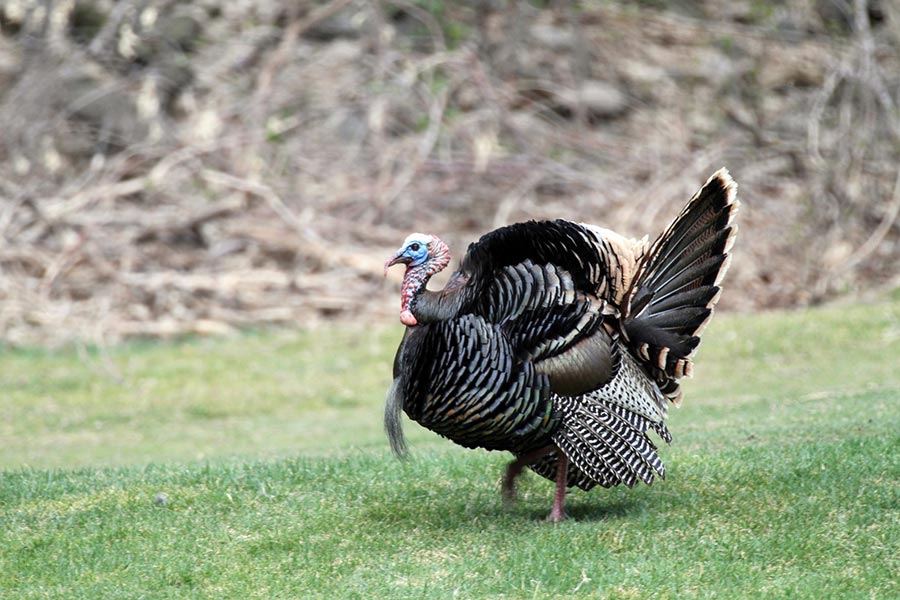What hunters should know about the 2020 Utah spring turkey hunts
Salt Lake City — While COVID-19 has canceled many events, Utah's spring turkey hunts are about to get underway and provide a great way to social distance while enjoying the outdoors.
Utah's youth turkey hunt runs from May 1–3, and the spring general-season turkey hunt runs from May 4–31. While turkey hunting is allowed in many areas across the state, some counties currently have rules and restrictions in place to prevent the spread of COVID-19, and those may affect your ability to visit, camp or recreate in the area. Make sure to check with each county for directives or restrictions specific to the area before you plan a hunting trip there. Find answers to common questions about hunting in Utah during COVID-19 on the Utah Division of Wildlife Resources website.
Here's what hunters should know about the upcoming hunts:
What hunting conditions will be like
There are two turkey subspecies that live in Utah: Rio Grande and Merriam's. There are currently between 25,000–35,000 wild turkeys throughout the state, and they're doing really well.
"Due to a favorable winter and early spring, overall, this year's general-season hunt should be better than in recent years," DWR Upland Game Coordinator Heather Talley said. "Conditions look really good for both bird numbers and hunter access in most areas across Utah."
Although statewide turkey populations are looking good, DWR biologists reported a decrease in turkey populations in northeastern Utah due to the deep snow in 2019 that lasted late into the spring.
Hunters should also note that high-elevation areas in southeastern Utah and other parts of the state may still be difficult to access due to recent spring rainstorms and substantial snowpack.
Where to hunt
For hunters targeting central Utah, some good areas to find turkeys include Payson Canyon, Spanish Fork Canyon, the Grindstone Ridge area and benches around Utah Valley. In southern Utah, hunters should look for birds in river corridor areas and their adjacent habitats.
For northeastern Utah, the corridors along the Duchesne River, the Green River and the Ashley Creek drainage should all be good areas to hunt turkeys this year. Lower agricultural areas should also have good turkey hunting, but many of these areas are private property, so hunters will need to get written permission from landowners before hunting. There are also pockets of turkeys throughout much of the Book Cliffs. Hunters should note that due to heavy snowfall in 2019, many of the turkeys that were found on higher-elevation U.S. Forest Service lands in northeastern Utah moved to lower-elevation areas and haven't returned to their usual high-elevation areas yet.
In northern Utah, turkeys can be found in Box Elder County on the north side of the Raft River Mountains up Clear Creek, One Mile, Johnson and Wildcat canyons. Hunters can also find turkeys in the Bear River Valley along the Bear River Corridor, as well as along the Wellsville Range from Deweyville to Willard and around Mantua. Turkeys can also be found in Cache County along the Wellsville Range and the Bear River Range, and along major drainages south of the Idaho border. Higher densities of birds can be found above Mendon, Wellsville, Clarkston, Cove, Richmond, Hyrum, Avon and Paradise. Turkeys can also be found on public lands above Kamas in Slate Creek and Yellow Pine at lower densities.
In southeastern Utah, hunters can find Merriam's turkeys in the La Sal and Abajo mountains. Popular areas to find Rio Grande turkeys in this part of the state include along the Colorado and Green rivers, as well as many of their tributaries such as the San Rafael River, Price River, Range Creek, Gordon Creek, Huntington Creek, Ferron Creek, and drainages along the Book Cliffs. Be aware that many areas along these waterways are private land, and hunters must get written permission from the landowner before hunting.
General tips
Rio Grande turkeys are usually found at lower elevations. River bottoms dotted with cottonwood trees and areas containing mostly oak and pinyon-juniper trees are some of their favorite spots. Merriam's turkeys, on the other hand, are typically found in ponderosa pine forests at higher elevations.
If you're planning to hunt, try to get out and scout a few days before your hunt begins. Becoming familiar with the area and locating where the turkeys are is key to a successful hunt. You should spend time observing the turkeys' daily patterns so that during the hunt, you can set up in an area where the birds will be active. Typically, more turkeys are harvested between 10 a.m. and 2 p.m. than during any other time of day.
"Turkeys are often found on private property, so be aware of the land ownership in the area you're hunting and remember that you must get written permission from the landowner before you can hunt on their property," Talley said. "Also, calls and decoys can greatly increase your success, so take time to practice with those beforehand. And lastly, turkeys have incredible eyesight so be sure to wear good camo and sit very still."
For other general turkey hunting tips, visit the DWR website.
Buying a turkey permit
You can buy a permit for the statewide general season anytime between now and when the hunt ends on May 31. General-season permits are available on the DWR website or at a variety of license agent locations and DWR offices. If you decide to buy a permit from a store or DWR office, make sure to maintain social distancing recommendations, and check to see if the store hours have been altered due to COVID-19.
For more information on season dates and permits, see page 36–37 of the 2019–20 Utah Upland Game & Turkey Guidebook. The free guidebook is available on the DWR website or at hunting license agent locations and DWR offices.
"Utah's turkey populations are doing great," Talley said. "Whether you're a long-time hunter or just getting started, this is a great time to get a tag and chase some gobblers."

















